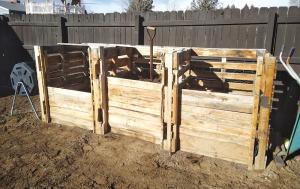2023 - Volume #47, Issue #3, Page #23
[ Sample Stories From This Issue | List of All Stories In This Issue | Print this story
| Read this issue]
Building An Inexpensive Composter
 |
He collected unwanted pallets from a local grocery store and warehouse, all free. “Make sure the wood hasn’t been treated,” he says. “You don’t want any chemicals seeping into your soil. The usable pallets will have a red or black stamp on one of the boards to indicate they are chemical free.”
After selecting the best pallets, he chose a sunny spot in one corner of his backyard. Three pallets were used for the back of his composter with one on either side. Everything was screwed together with 3-in. galvanized wood screws. The result was a frame 12 ft. long, 4 ft. wide, and 4 ft. high.
Within that frame, he used two additional pallets as dividers, making three total bins for compost rotation and storage. He lined each of the bins with galvanized chicken wire to keep compost from spilling out any cracks.
As a final step, Waller cut additional boards with his skil saw to fit across the front to contain the compost. He made them removable so he could turn the compost more easily at any height. The entire process took less than a day, with only the costs for a box of 3-in. wood screws and a roll of chicken wire.
The first bin was layered with yard clippings, leaves, cow manure from a local rancher, and non-meat kitchen scraps. “Think browns and greens when creating your compost,” Waller says. “Browns, like leaves, are needed for carbons. Greens like vegetable peelings are great sources of nitrogen.”
To aid in the composting process, three times a week during the growing season, Waller turns things, pitchforking the material back and forth from the first bin to the center bin. When finished, he also waters the material down to help activate the microbes, which must be kept moist.
A composting thermometer, periodically inserted into the mix, keeps the heat monitored to 140 degrees, although “anything up to 120 degrees is good. Don’t let the temperature get much above that, or the microbes will die off.”
The third bin receives the finished product - rich, dark, and moist dirt that is tilled into the garden and the flower beds and mixed with potting soil for house plants. “I always have enough to share with the neighbors, too,” Waller says. “My wife’s indoor lemon tree produced fourteen lemons last fall because of compost. She’d barely gotten anything to grow on it before. It’s like gold, good for just about anything.”

Click here to download page story appeared in.

Click here to read entire issue
To read the rest of this story, download this issue below or click here to register with your account number.




